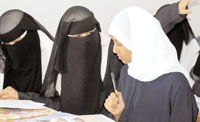
The Education Ministry launched a project to improve secondary education and girls’ enrolment in schools which will target about 90 schools in 30 different districts. Only 25 out of every 100 girls enrolled in primary school complete their primary schooling, restricting the number of the girls who will pursue secondary education. The project, which started early last month, aims to improve the indicator between girls and boys enrolment in secondary education in the targeted districts from 0.42 to 0.66. It also aims to develop the rate of continuing on to classes 10-12 in the districts from 80% to 85.4% for boys and from 84.2% to 89.1% for girls. The project works on bridging the gender gap and modernizing schools facilities to reach the accepted standards. The project will also finance facilities like science laboratories, computers, and multimedia rooms. Intensive training for members of society will also be offered, especially to the councils of fathers and mothers as well as to school administrations.Financial aid for transportation and partial scholarships will be provided for girls in classes 4-12 and for boys in classes 10-12 in the targeted districts, where 50% of people are living under the poverty line. Training for teachers, supervisors, and directors of the targeted schools will be developed and schools’ syllabi will be updated throughout the course of the project. Teachers’ training will commence during and before the period of service. A follow-up study for the graduates of the secondary schools will be conducted in order to evaluate outcomes. The project will begin in five of the target nine governorates within the next 18 months. It will later expand to cover the other four governorates within 18-24 months after launching the project. The incompetence in secondary education coupled with the unreasonable distribution of teachers plays a huge role in the high rates of failure and dropouts. These issues will be targeted by the Education Ministry via this project.The project is mainly financed by the International Development Agency and other supporters at USD 20 million.